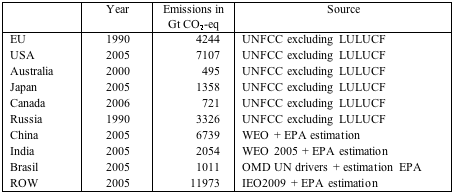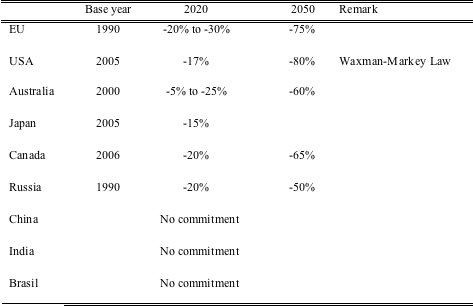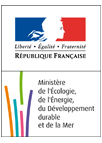Scenario Choices
The following five scenarios have been analysed and compared to the baseline scenario (or b.a.u.). They correspond to different degrees of international cooperation to reach the goal (common to all scenarios) to limit the temperature change to 2°C compared to pre-industrial level.
- Failure of negotiations
- Minimum agreement in OECD
- Agreement in OECD plus Russia
- Agreement wthin G20
- International agreement (global)
From a fragmented climate regime to a unique price of carbon
Targets in climate policies are defined relative to a base year for developed countries. The base years have been indicated in the commitments of the countries (see Table 1). For developing countries, the base year is 2005.
Currently the climate policies are characterized by what is commonly called a fragmented regime. Different countries of Annex 1 were individually engaged in the implementation of various measures (taxes, standards, incentive program, etc.) that result in a set of carbon prices (explicit or implicit) that have little chance to converge toward a common value. Only the EU ETS market does represent a successful attempt to reach a common price for CO2 for a set of economic sectors in different countries. This fragmentation may eventually hinder the development of more ambitious policies and lead to very high disparities in CO2 prices. Furthermore, according to economic theory this is a source of inefficiency, so there is real gain to make these prices converge to a single price (Tirole (2009)). The convergence of these prices necessitates a generalization of the ETS from European countries to other countries in Annex 1 and further, to developing countries. The assumption of the study reported here, is that starting in 2020, a global market for CO2 is in place leading to a single price for CO2. Trading is set up to exchange rights that are equal to the commitments of each country. This assumption represents the best case for achieving cost effectiveness, even though it does not imply necessarily a global market accessible to all (household, business, government). Multiple markets (ETS Global, CDM, carbon market between nations, national tax, etc.) are also possible, provided permeability and monitoring are carried out effectively enough to get a single world price.
In these simulations the Quotas allocated within EU are based on the Population in 2001.

For industrialized countries, the commitments or proposals made for 2020 and 2050 have been retained (see Table 2). For the intermediate years, the target is obtained by linear interpolation. No international market for tradable emission permits is established before 2020. After 2020 one assumes that an international tradable permit market is gradually established, leading to a single price for carbon.

Evolution of the European ETS market
In TIAM, Europe is represented by one region, assuming by default a perfect cooperation between all countries to satisfy the climate target at the European level by 2020. After 2020, Europe participates to the International carbon market as defined by each scenario.
GEMINI-E3 includes each European country separately, and assumes that until 2020 Europe will implement the energy-climate package, which means a common carbon price in ETS sector and CO2 prices within each country for non-ETS sectors, on the basis of allowances specified in the EU-directiveon energy & climate. Starting from 2021 one assumes the participation of the European Union in a global market for CO2. The "burden sharing" of each country must then be defined and be negotiated taking into account the overall objective of -75% in 2050 compared to 1990 level. In this study, different allocation rules based on multiple equity criteria (population, emission, GDP) will be considered by varying the weight of each criterion. The scenarios assessed in the present study assume that the "burden sharing" between European countries is based on the population of each member.

